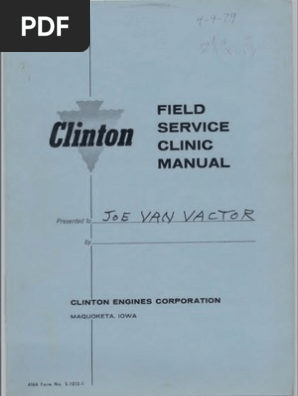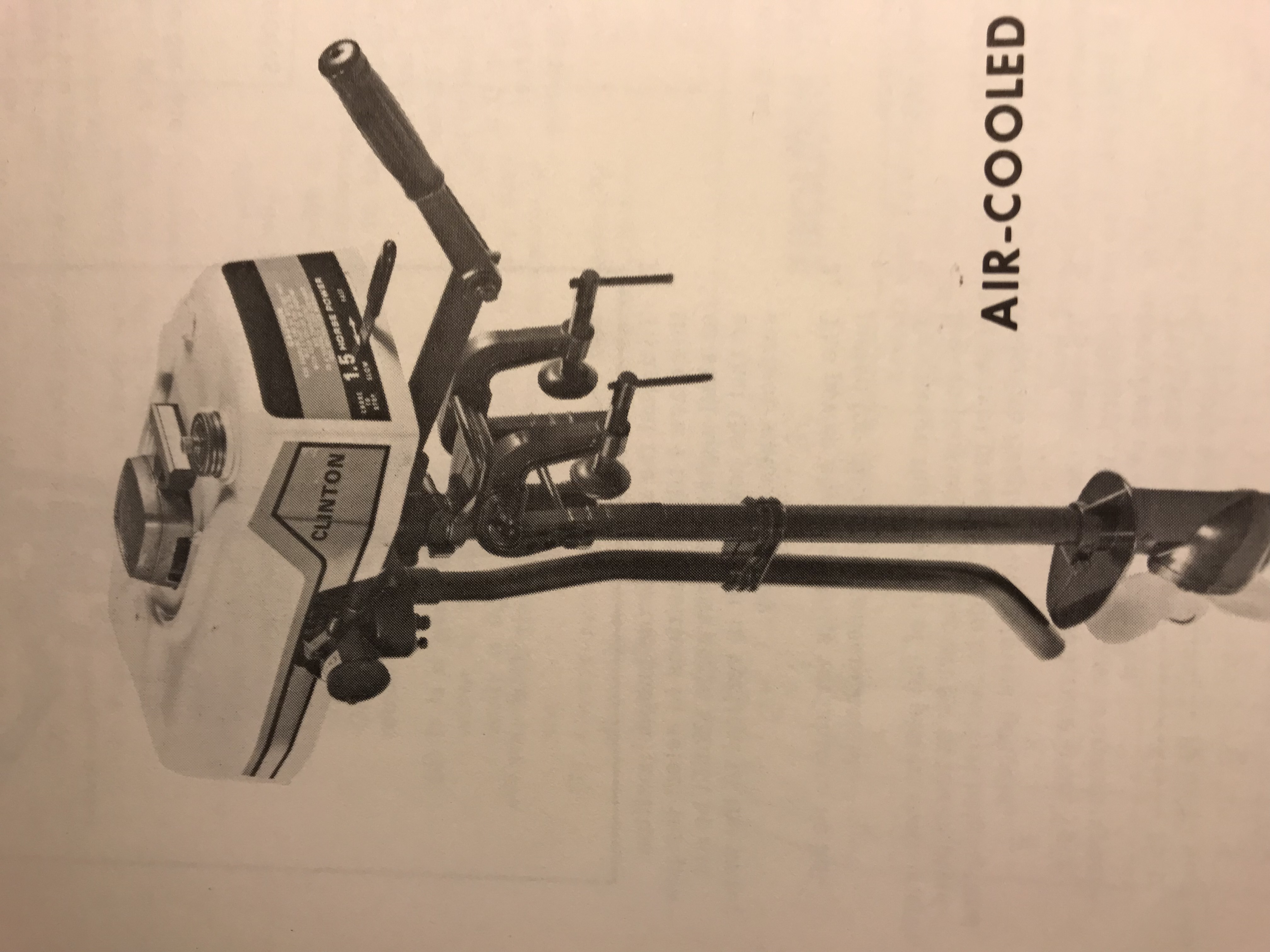
A rotary mower with a 21 inch blade and an engine speed of 3,000 rpm has a tip speed of 187 mph. If the operator walks at approx. 3 miles per hour the blade tip will pass over any given area 6 times, and a blade sharpened 3 inches on each end with the engine rpm at 3,000 only uses the first ½inch of the 3 inch sharpened length actually to cut grass. In order for the blade to cut the grass the full 3 inches of sharpened area the mower would have to travel 18 mph.
In 1951Clinton started production in Maquoketawith1 standard engine and 515 Model variations for the Original Equipment Manufacturers, {O.E.M}. By 1966 that figure had grown to 7 different engine categories, 181 standard engines and 7,677 model variations.
See full list on classic-engines.com. I'm really excited about this motor! To be honest with you, I never heard of Clinton engines before I bought this outboard. My 7 year old daughter wants me to take her lake trout fishing really bad and my dad has a boat with no motor, so I bought the Clinton sight-unseen from a buddy at work for $50 figuring it would be a good cheap junker that I could just toss out when it.
Clinton engines were sold and serviced by more than 62 Distributors, 845 Service Distributors, 12,000 dealers, 800 OEM Accounts in the United States and 88 outlets in off shore countries.
An estimated two-thirds of Clinton’s 2 and 4 cycle engines went into the power mower market.
In 1958 Clinton was given the title of “The World’s Largest Small Engine Producer”.
Clinton in 1952 introduced its own line of chainsaws for use in logging, cutting firewood, land clearing, agriculture, and utility companies and landscaping.
In 1953 Clinton introduced its own line of 5 hp. air and water cooled outboards mainly utilized for fishing and trolling. They were also used as “kickers”, auxiliary power, to get back to the home dock in case the larger outboard motor stopped running. In 1966 a larger 9.9 outboard was added to be utilized on larger boats.

During May of 1966 Clinton received the coveted “E” award for excellence in the export arena from the President of the United States. Clinton was the first engine manufacturer to receive such award.

Looking for different type of engine power Clinton designed a Wankel engine one/half the size of the 1600 Series Red Horse Engine in the early 1960s. While 80 % of design criteria was met in order to reduce high rpm and improve the engine torque calculations indicated a speed reducer would be required. This in turn created too heavy an engine so the project was canceled. A display at the Clinton Engines Museum contains blueprints and engineering sketches along with various engineering mechanical calculations.
Probably the cheapest and highest quality purchased part outside of hardware, was the Spark plug. Rarely was a reject on the assembly line or in the test department ever found. There were 2 pricing levels Purchasing had to deal with. If the plug went into an engine the cost ran from .06 to 10 cents. If the plug was for the Service requirements, the cost became .30 cents to which marketing priced out at $1.03 retail. The plug manufacturer along with Purchasing always kept an eye on purchased requirements and where they were intended to be used.
The Government decree in the 1950s to small engine manufacturers was that all manufactured engines develop at least 95% of the decal horsepower after break in. Power loss will decrease 3% for each 1,000 ft. above sea level, and 1% for each 10 degrees F. above the std. temperature of 60 degrees F. Governors to be set at 3,000 rpm. Production engines shipped not broken in must develop 85% of decal horsepower. A formula Clinton adhered too.
Over the years Clinton colors for Standard engines were Dark Green, Red, White, Yellow and Gray. The colors for the 800 OEM accounts included many different shades of a standard color, I.E. 6 different shade of red, 4 shades of white, etc, etc. In all the years of production in Iowa an OEM account was never painted a wrong color.
In 1960 Clinton along with the Clevelite Corp. developed a revolutionary new ignition system, called “Dyna Spark” utilizing the Piezoelectric concept. This was a fore runner of today’s solid state ignition systems, no points or condenser. Clinton decided to put the unit on the commercial engine Clint alloy 407 series. Proto typing was done and the unit performed to engineering standards. Last minute cost increases to Clinton were not acceptable so the project was canceled. 5 engines of the proto type run were not returned to Clinton. Today there is only one known engine in the hands of a collector.
Congress in 1962 decreed that a device is needed on all rotary mowers that give the operator the ability to stop the blade prior to hitting an object. The mower industry lobbied and failed to defeat the measure at that point in time. Clinton in 1963 introduced its version of a “Touch “n Stop” that allowed to operator the requested option. Congress had second thoughts and killed the idea and Clinton never produced this model variation.
The first Clinton Engines factory was established in 1946 to manufacture small general-purpose air-cooled gasoline engines. It was first located in Clinton, Iowa, where 150 employees started producing a 1.5-horsepower engine. Initial production was approximately 225 engines a week. By 1947, the company had approximately 1,000 employees.
In 1948, two additional models were added to the line — one a 2-horsepower engine; the other, a 3-horsepower engine.In 1950, Clinton purchased a 200,000-square-foot manufacturing facility in Maquoketa, Iowa, built five years previously for a manufacturer of farm equipment. Since then the plant has been enlarged to 250, 000 square feet. From the original 1.5 horsepower, 4-cycle engine Clinton now makes a total of 16 basic models ranging from 2 1/2 to 10.3 horsepower, of 2-cycle and 4-cycle design, horizontal and vertical crankshaft.
Old Johnson Outboard Motors Identification
During the company’s operation, it was one of the largest suppliers of these engines. Although Clinton engines were used principally on power lawn mowers, hundreds of original-equipment manufacturers used Clinton engines on their power equipment. Among the thousands of applications in which Clinton engines played a vital role were garden tillers, paint sprayers, post-hole augers, tractors, well-drilling equipment, rail-spike hammers, sprayers, compressors, emergency generators, and many other areas for home, industry, and agriculture. One of the largest outlets for Clinton engines was the power lawn mower market — an estimated two-thirds of the corporation’s engines went into this field.
In addition, Clinton also produced complete lines of chainsaws and air-cooled outboards from 3 to 9.9 horsepower engines at the Maquoketa, Iowa, plant. Clinton engines were sold and serviced by more than 12,000 dealers in the United States and had 88 outlets in foreign countries.
Innovation
Clinton was the first in the industry to:
Clinton Outboard Identification
- Mass produce vertical-shaft engines for rotary lawn mowers
- Introduce an automotive-type oil pump in a 4-cycle engine and the “dry-type” automotive air filter
- Use shell-molded engines
- Use a cast-iron liner, cast as an integral part of the cylinder block, in lightweight aluminum engines
Highlights
In 1952, Clinton introduced its own line of chain saws. The saws were used in agriculture, home construction, and by utility companies for clearing land, landscaping, and cutting timber and pulpwood.
In 1953, Clinton entered the export market. In later years, Clinton accounted for one-third of all air-cooled engines sold under 10 horsepower overseas.
In 1957, Clinton introduced its own line of 5-horsepower air-cooled outboard motors. Ideal for fishing, trolling and cruising, they could provide stand-by auxiliary power for small and medium-sized sailboats, as well as for dinghies, canoes, or any type of wood, fiberglass or aluminum craft. In 1966, a 9.9-horsepower air-cooled unit was added.
In May 1966, Clinton received the coveted “E” Award for excellence in export from the President of the United States, the first engine manufacturer to be so honored.


